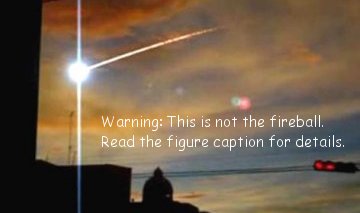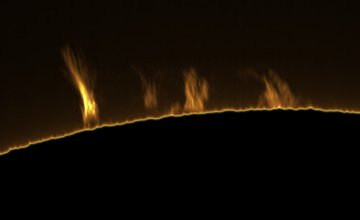 Where's Saturn? Is that a UFO--or the ISS? What's the name of that star? Get the answers from mySKY--a fun new astronomy helper from Meade. Where's Saturn? Is that a UFO--or the ISS? What's the name of that star? Get the answers from mySKY--a fun new astronomy helper from Meade. SUPER-BOLIDE: On Wednesday, July 25th at approximately 10:00 UT, "a major daylight fireball tore across the skies of Slovenia, Croatia and Italy," reports veteran meteor observer Jure Atanackov of Maribor, Slovenia. "It produced two bright flashes that reached an estimated magnitude of -20 and also loud sonic booms." Magnitude -20? In plain language, the meteor was 600 times brighter than a full Moon. Atanackov has gathered reports from hundreds of eyewitnesses. "Most described the fireball as very bright, its surface brightness almost as great as the Sun's. One person said it was 'too bright to look at for more than a few moments.'" 
Above: This is not the fireball. The image was posted by a Croatian news service as an example of what the fireball looked like. Non-speakers of Croatian misunderstood and widely circulated the photo as a genuine record of the event. The July 25th fireball falls into the category of superbolides--exploding meteors of magnitude -17 or brighter. They are, essentially, small asteroids measuring a few to 10 meters in diameter and massing a few hundred metric tons. Superbolides trigger seismic detectors on the ground, produce waves of infrasound that can travel thousands of miles, and they are tracked by military satellites scanning Earth for nuclear explosions. Recent examples include the El Paso fireball of 1997 and the Yukon fireball of 2000. Eyewitnesses, please report your sightings to Jure Atanackov or colleague Javor Kac who are gathering data to learn more about the "Slovenian Superbolide" and to estimate possible landing sites. PROMINENCE ALERT: "What a nice surprise," says Mark Hanson of Middleton, Wisconsin. "This morning I was testing a new focal reducer for my SolarMax90 when these nice prominences popped up." 
They may look like flames, but prominences are something different: gigantic clouds of hydrogen held together by solar magnetic fields. Shortly after Hanson snapped the photo, above, Robert Morlan of
La Porte, Indiana, caught the tallest prominence apparently breaking free: image. This happens sometimes when a prominence's magnetic field becomes unstable. Astronomers, now is the time to monitor developments. more images: from N. Lowell, S. Hatfield and J. Stetson of South Portland, Maine; from P-M Hedén of Vallentuna, Sweden; from Tom Masterson of Ferndale, Washington; from Robert Arnold of Isle of Skye, Scotland; and a sketch from Les Cowley of the UK.
.2007 Noctilucent Cloud Gallery
[Night-Sky Cameras] ["Noctilucent Cloud"--the song] | 
